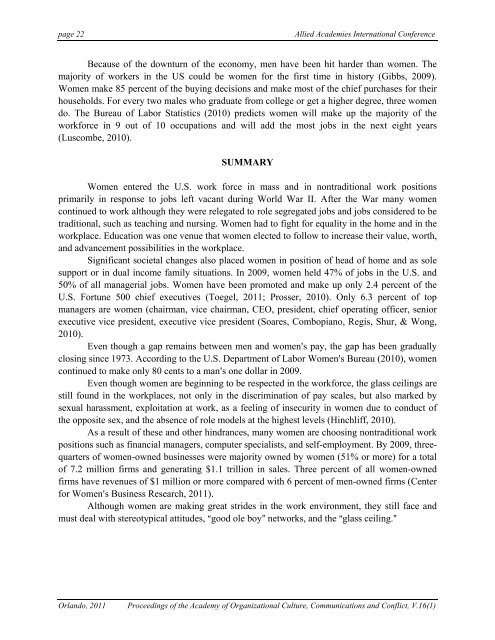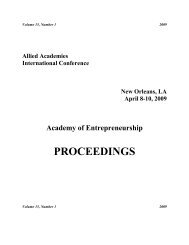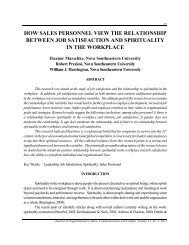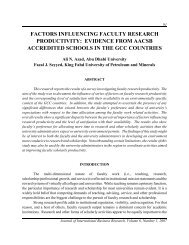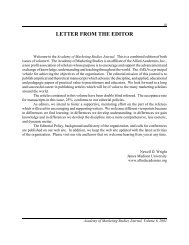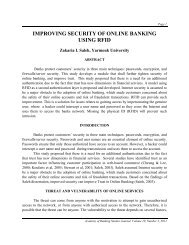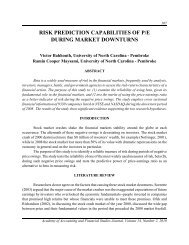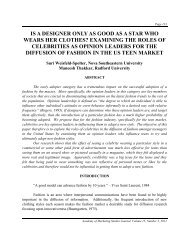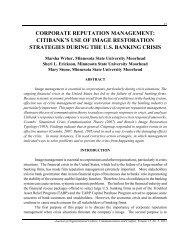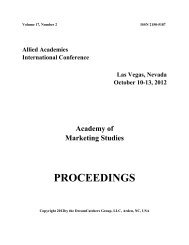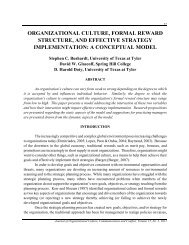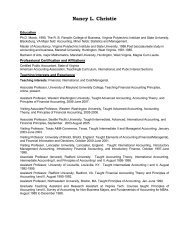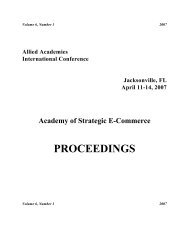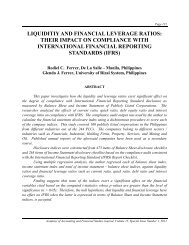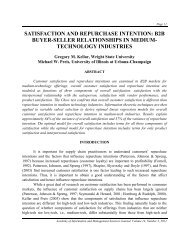AOCCC - Allied Academies
AOCCC - Allied Academies
AOCCC - Allied Academies
You also want an ePaper? Increase the reach of your titles
YUMPU automatically turns print PDFs into web optimized ePapers that Google loves.
page 22<br />
<strong>Allied</strong> <strong>Academies</strong> International Conference<br />
Because of the downturn of the economy, men have been hit harder than women. The<br />
majority of workers in the US could be women for the first time in history (Gibbs, 2009).<br />
Women make 85 percent of the buying decisions and make most of the chief purchases for their<br />
households. For every two males who graduate from college or get a higher degree, three women<br />
do. The Bureau of Labor Statistics (2010) predicts women will make up the majority of the<br />
workforce in 9 out of 10 occupations and will add the most jobs in the next eight years<br />
(Luscombe, 2010).<br />
SUMMARY<br />
Women entered the U.S. work force in mass and in nontraditional work positions<br />
primarily in response to jobs left vacant during World War II. After the War many women<br />
continued to work although they were relegated to role segregated jobs and jobs considered to be<br />
traditional, such as teaching and nursing. Women had to fight for equality in the home and in the<br />
workplace. Education was one venue that women elected to follow to increase their value, worth,<br />
and advancement possibilities in the workplace.<br />
Significant societal changes also placed women in position of head of home and as sole<br />
support or in dual income family situations. In 2009, women held 47% of jobs in the U.S. and<br />
50% of all managerial jobs. Women have been promoted and make up only 2.4 percent of the<br />
U.S. Fortune 500 chief executives (Toegel, 2011; Prosser, 2010). Only 6.3 percent of top<br />
managers are women (chairman, vice chairman, CEO, president, chief operating officer, senior<br />
executive vice president, executive vice president (Soares, Combopiano, Regis, Shur, & Wong,<br />
2010).<br />
Even though a gap remains between men and women=s pay, the gap has been gradually<br />
closing since 1973. According to the U.S. Department of Labor Women=s Bureau (2010), women<br />
continued to make only 80 cents to a man=s one dollar in 2009.<br />
Even though women are beginning to be respected in the workforce, the glass ceilings are<br />
still found in the workplaces, not only in the discrimination of pay scales, but also marked by<br />
sexual harassment, exploitation at work, as a feeling of insecurity in women due to conduct of<br />
the opposite sex, and the absence of role models at the highest levels (Hinchliff, 2010).<br />
As a result of these and other hindrances, many women are choosing nontraditional work<br />
positions such as financial managers, computer specialists, and self-employment. By 2009, threequarters<br />
of women-owned businesses were majority owned by women (51% or more) for a total<br />
of 7.2 million firms and generating $1.1 trillion in sales. Three percent of all women-owned<br />
firms have revenues of $1 million or more compared with 6 percent of men-owned firms (Center<br />
for Women=s Business Research, 2011).<br />
Although women are making great strides in the work environment, they still face and<br />
must deal with stereotypical attitudes, Agood ole boy@ networks, and the Aglass ceiling.@<br />
Orlando, 2011<br />
Proceedings of the Academy of Organizational Culture, Communications and Conflict, V.16(1)


